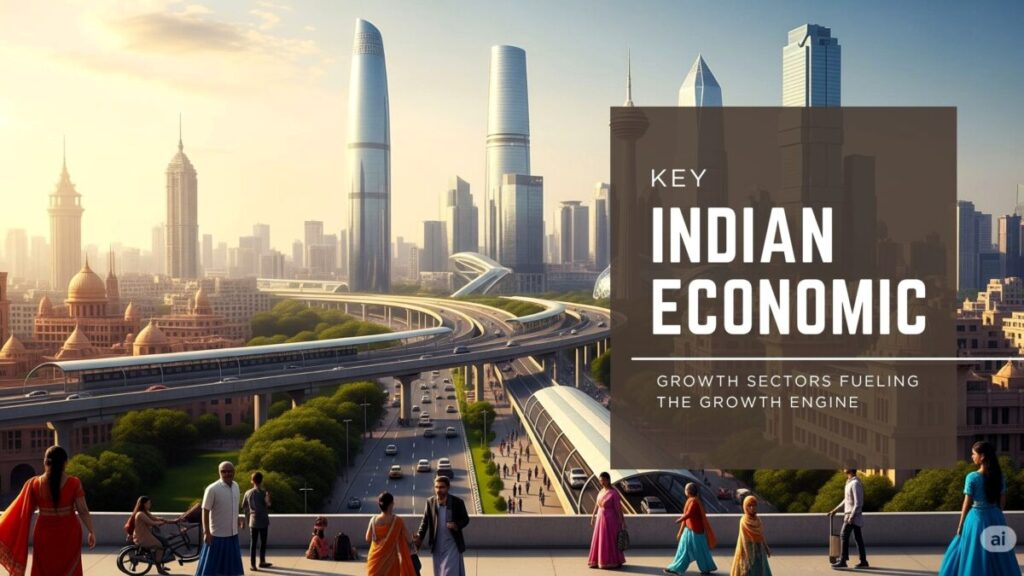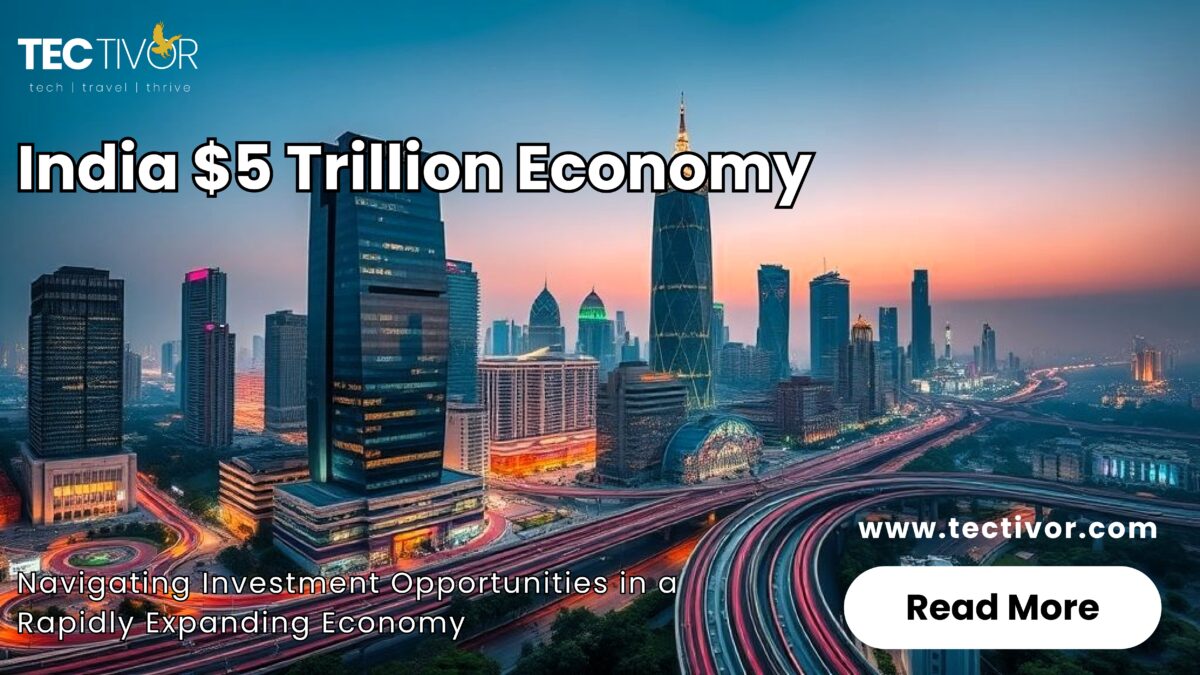India $5 Trillion Economy: Union Minister Piyush Goyal’s recent assertion that India is on track to become a $5 trillion economy within the next three years has sent ripples of optimism through the financial world. This ambitious goal, if realized, signifies a monumental leap for the Indian economic landscape and presents a plethora of exciting opportunities for astute investors. But what does this target truly entail, and which sectors are poised to be the engines of this remarkable growth?
Reaching the $5 trillion milestone is not merely about a larger GDP figure; it signifies increased purchasing power, a burgeoning middle class, enhanced global influence, and a more robust and resilient economic structure. For investors, it translates to a dynamic market ripe with potential for significant returns. However, navigating this landscape requires a keen understanding of the sectors that are likely to spearhead this expansion.
Table of Contents
Key Indian Economic Growth Sectors Fueling the Growth Engine
Several sectors are expected to be pivotal in propelling India towards its $5 trillion goal:
Manufacturing:
The government’s strong emphasis on “Make in India” and initiatives like Production Linked Incentive (PLI) schemes are designed to boost domestic manufacturing. This push aims to reduce reliance on imports, create employment, and position India as a global manufacturing hub. Investors can look at sectors like electronics, automobiles and auto components, pharmaceuticals, and textiles, which are witnessing significant government support and investment inflows.
Infrastructure:
A robust infrastructure backbone is crucial for sustained economic growth. Massive investments are being made in improving roads, railways, ports, airports, and energy infrastructure. This sector offers long-term investment opportunities in construction, engineering, and related industries. The government’s National Infrastructure Pipeline outlines ambitious projects, providing a clear roadmap for investors.
Digital Economy:
India’s digital transformation is already underway, with a burgeoning e-commerce market, a thriving fintech sector, and increasing adoption of digital technologies across industries. The government’s push for digital payments, the growth of the IT and ITeS sectors, and the emergence of new technologies like AI and blockchain present significant investment potential. Companies focusing on software development, digital infrastructure, cybersecurity, and online services are likely to thrive.
Healthcare and Pharmaceuticals:
The COVID-19 pandemic underscored the importance of a strong healthcare infrastructure and a robust pharmaceutical industry. Increased government spending on healthcare, rising health awareness, and India’s position as a global pharmaceutical hub create attractive investment opportunities in hospital chains, diagnostics, medical devices, and pharmaceutical research and manufacturing.
Agriculture and Food Processing:
While often overlooked, the agriculture sector remains a significant contributor to the Indian economy. The government’s focus on modernizing agriculture, improving irrigation facilities, and promoting food processing industries can unlock substantial growth in this sector. Investments in agri-tech, food processing units, and supply chain infrastructure can yield promising returns.
Financial Services:
A well-functioning financial system is the lifeblood of a growing economy. The expansion of banking and non-banking financial institutions, the growth of the capital markets, and the increasing penetration of insurance are crucial for supporting economic activity. Investors can explore opportunities in banking, insurance, asset management, and other financial services sectors.

Investment Considerations and Opportunities:
As India marches with unprecedented momentum towards its ambitious $5 trillion economy goal, a truly vast and diverse array of investment opportunities in India are rapidly emerging, demanding that both domestic and international investors adopt a highly strategic, thoroughly informed, and forward-looking approach. The optimistic pronouncements, including Piyush Goyal’s economy statement on this trajectory, underscore a transformative period for the nation’s financial landscape.
- Long-term Perspective: Cultivating Patience for Profitable Returns
Investing in India’s dynamic growth story is fundamentally an exercise in long-term vision. The monumental benefits stemming from the ongoing economic reforms, the extensive infrastructure development projects, and the deepening digital penetration are not overnight phenomena; they are designed to accrue substantial value over an extended period. Consider, for instance, the gestation period of large-scale infrastructure projects like the dedicated freight corridors or new industrial corridors; their full economic impact will be felt over decades, not quarters. Similarly, the structural shifts in manufacturing driven by “Make in India” initiatives require sustained investment and policy support to yield a globally competitive ecosystem. For investors, this means looking beyond short-term market fluctuations and instead focusing on the fundamental strengths being built, which will define the India Economic Outlook 2027 and beyond. Patience combined with conviction in India’s demographic dividend and increasing consumption power is paramount for realizing the full potential of these investments. - Sector-Specific Research: Unlocking Niche Potential within Growth Engines
Beyond a broad understanding of India’s macroeconomic narrative, deeply understanding the intricate dynamics of each specific sector is absolutely crucial for identifying truly compelling investment opportunities in India. This involves meticulous sector-specific research: dissecting market trends, identifying key disruptive players, analyzing their competitive advantages, and rigorously assessing their growth potential within the context of the larger Indian Economic Growth Sectors. For example, within the digital economy, understanding the nuances between fintech, ed-tech, and health-tech startups can lead to more targeted and profitable investments. In manufacturing, distinguishing between the growth trajectories of electronics assembly, automotive components, or specialized chemicals will be key. This granular analysis allows investors to pinpoint companies that are not just growing with the tide, but are poised to outperform due to innovation, market leadership, or unique strategic positioning, directly contributing to the $5 trillion economy target. - Risk Assessment: Navigating the Complexities of a High-Growth Market
While the promise of significant growth and the pathway towards the $5 trillion economy is undoubtedly enticing, astute investors must remain highly mindful of the inherent risks associated with a rapidly evolving market like India. These include potential global economic headwinds that could impact trade and capital flows, unforeseen regulatory changes that might affect specific industries (e.g., in e-commerce or digital payments), and critical execution challenges in large-scale projects or policy implementation. Furthermore, geopolitical shifts and commodity price volatility can also play a role. A robust risk assessment involves not only identifying these potential pitfalls but also evaluating the resilience of companies and sectors to absorb such shocks. Diversifying across different sectors, company sizes, and even asset classes can significantly mitigate idiosyncratic and systemic risks, ensuring a more stable journey towards maximizing investment opportunities in India. - Diversification: The Cornerstone of a Resilient Portfolio
In the pursuit of maximizing returns from India’s growth story, strategic diversification across different Indian Economic Growth Sectors is not just advisable, but essential. Concentrating investments in a single high-growth area, while potentially lucrative, also amplifies risk. By spreading investments across promising areas like manufacturing, digital services, healthcare, infrastructure, and even renewable energy, investors can balance exposure and enhance overall portfolio returns. For instance, if one sector faces temporary headwinds due to policy changes or global slowdowns, the positive performance of another diversified sector can provide a cushion. This balanced approach is crucial for navigating the nuances of the India Economic Outlook 2027 and beyond, allowing investors to participate broadly in the nation’s ascent towards the $5 trillion economy while minimizing the impact of sector-specific volatility. Diversification also extends to asset classes – considering a mix of equities, fixed income, and real estate, depending on individual risk appetite and financial goals. - Government Policies: Decoding the Blueprint for Future Growth
Staying meticulously abreast of government policies, key initiatives, and ongoing reforms is perhaps one of the most critical aspects for understanding the precise direction of India’s economic growth and identifying emerging investment opportunities in India. Policies like the Production Linked Incentive (PLI) schemes directly channel investments into specific manufacturing sectors. The government’s continued push for digital transformation, including initiatives like the Open Network for Digital Commerce (ONDC), is reshaping e-commerce and logistics. Understanding the nuances of the National Infrastructure Pipeline provides a clear roadmap for investment in construction and related industries. Furthermore, the implications of recent budgets and statements, such as Piyush Goyal’s economy statement on the $5 trillion goal, signal the government’s priorities and commitment. For investors, this proactive tracking of policy landscape is akin to having an early warning system, enabling them to align their investment strategies with the national growth agenda and capitalize on the sectors poised for exponential expansion.
Conclusion:
The ambitious Piyush Goyal economy statement about India’s $5 trillion economy goal within three years is more than just rhetoric; it reflects the underlying momentum and potential of the Indian economy. While the journey will undoubtedly have its challenges, the opportunities for investors are immense. By carefully analyzing the key growth sectors, adopting a long-term perspective, and conducting thorough due diligence, investors can position themselves to benefit from India’s remarkable economic transformation.
The next few years promise to be an exciting chapter in India’s growth story, and for those who invest wisely, the rewards could be substantial. Looking at the India economic outlook 2027 and beyond, the next few years promise to be an exciting chapter in India’s growth story, and for those who invest wisely, the rewards could be substantial.
💡 Stay ahead of the future! Follow us on:
Facebook | LinkedIn


